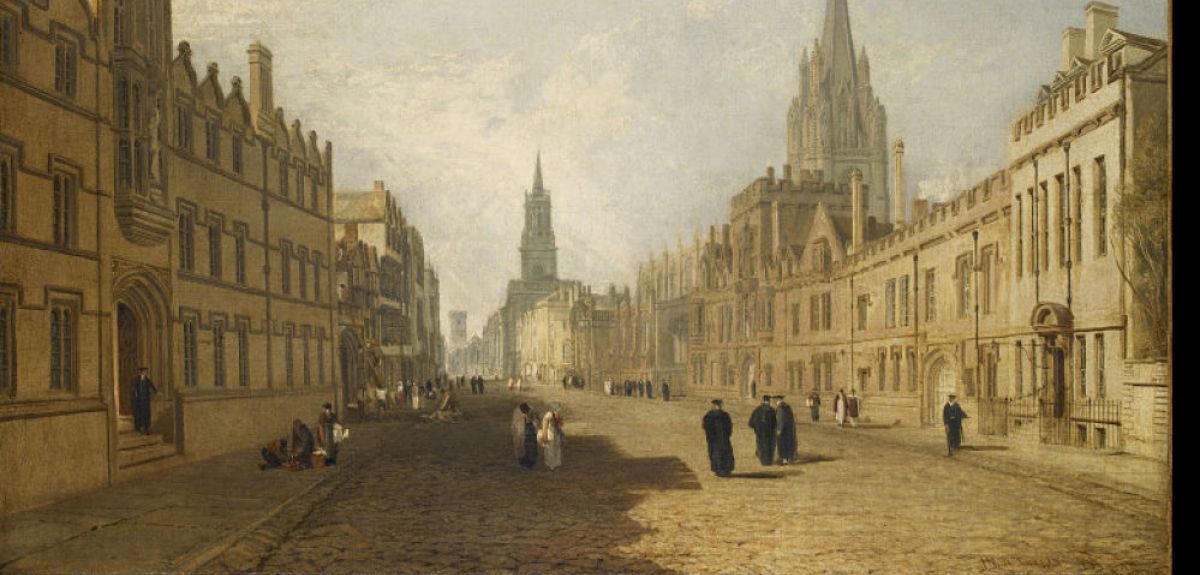
Private collection courtesy of the Ashmolean Museum, University of Oxford
Ashmolean campaigns to acquire major painting by JMW Turner
The Ashmolean Museum has launched a public campaign to raise the final £60,000 needed to secure for the nation a major work by Joseph Mallord William Turner.
The High Street, Oxford (1810), which has been on loan to the Museum from a private collection since 1997, has been offered to the nation in lieu of inheritance tax. The painting would settle £3.5 million of inheritance tax – which is more than the tax liable on the estate - so the Ashmolean must raise the difference, £860,000, to acquire the painting.
Over 90% of this sum has been secured already. The Museum has received lead support from the Heritage Lottery Fund (HLF) with a grant of £550,000; a grant of £220,000 from the Art Fund; and a further £30,000 from the Friends and Patrons of the Ashmolean.
The High Street, Oxford depicts a street which has materially changed little since Turner painted it. Although he painted many townscapes in watercolour, Turner never again attempted such a picture in oils.
Dr Alexander Sturgis, Director of the Ashmolean, says: 'The importance of keeping this beautiful painting in Oxford cannot be overstated. High Street, Oxford is the young Turner's most significant townscape and the greatest painting of the city that has ever been made.
'We are profoundly grateful to the Heritage Lottery Fund, the Art Fund and our patrons who have already shown their support for this campaign. If the Ashmolean does not acquire the painting, it will be sold on the open market. All major oil paintings by Turner that have been offered at auction in recent years have been bought by foreign buyers.'
Over the summer, the Ashmolean will mount public events giving the people of Oxford and the city's thousands of tourists the chance to engage with the painting in the place where it was created. A photography competition, 'My View of Oxford', will be launched in June, encouraging photographers of all ages and abilities to respond to the Turner by capturing their personal view of the city. The winning entries will be shown in the Museum later in the summer.
On the streets of Oxford, full-size reproductions of the painting will be displayed in prominent locations, encouraging the public to join the campaign and visit the Ashmolean to see the original picture.
Acknowledged as one of the greatest landscape artists of all time, Turner painted over thirty finished watercolours of Oxford views, by far the most numerous group devoted to a single place in his entire output. He was familiar with the architecture of the city, having visited relations in the village of Sunningwell (five miles southwest of Oxford) during his childhood.
In 1799, he received his most prestigious commission to date, to provide two designs for the University’s annual calendar, the Oxford Almanack. The success of these two watercolours led to commissions for a further eight, published between 1799 and 1810. They show a deliberately wide variety of street scenes, colleges and interiors. It was, no doubt, the quality of these pictures that led Oxford printseller, James Wyatt, to commission the view of the High Street.
The painting is one of the most fully documented of all Turner's works because Wyatt kept his correspondence with the artist which was included in his posthumous sale. The original purpose of the commission was to have the design engraved. Wyatt settled on an oil painting, instead of a watercolour, half the size of Turner's normal canvases, at a cost of 100 guineas. The artist worked on the painting over the winter of 1809–10, consulting Wyatt on the details of the architecture included in the view.
The final stage involved the introduction of figures, members of the University and clergy, and some women ‘for the sake of colour’. The painting was completed in March 1810 and was exhibited in Wyatt’s shop before being shown at Turner’s own gallery in his house in Queen Ann Street. Wyatt was evidently delighted and commissioned a pendant View of Oxford from the Abingdon Road (private collection). Both were exhibited at the Royal Academy in 1812. When, in the 1830s, Turner was choosing views of Oxford for his greatest series of watercolours, he rejected the High Street. He felt that, in the painting of 1810, he had achieved an unparalleled view of technical mastery that he could not repeat.
Stuart McLeod, Head of Heritage Lottery Fund South East England, says: 'It would be unthinkable for this particular painting, unique among Turner's work, not to remain on public display in the city. We have been delighted to support its acquisition and wish the Ashmolean well in its public appeal for the balance of the funding required.'
Stephen Deuchar, Director of the Art Fund, says: 'This most important picture simply must be saved by the Ashmolean: we’re pleased to have supported the campaign substantially ourselves and fervently hope that anyone else who loves Turner, Oxford and the Ashmolean, will now do the same.'
 International collaboration launches largest-ever therapeutics trial for patients hospitalised with dengue
International collaboration launches largest-ever therapeutics trial for patients hospitalised with dengue
 Oxford-built multi-agent assistant for cancer care to be piloted in collaboration with Microsoft
Oxford-built multi-agent assistant for cancer care to be piloted in collaboration with Microsoft
 World's first Phase II Nipah virus vaccine trial launch
World's first Phase II Nipah virus vaccine trial launch